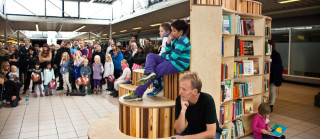Playful and serious: Four architects’ initiatives

Young architects explore the possibilities of more a pro-active role in order to address potentials and shortages in specific urban situations. In my presentation at the “Re-designing the Gap” in Oslo, I presented and discussed a small selection of contemporary works in Norway and Oslo.
ffb (felleskapsprosjektet å fortette byen) is operated by Eystein Talleraas, Håvard Arnhoff and Joar Nango. They have concentrated on minorities, exploring temporary interventions and nomadic aesthetics, as for the “Norwegian-Roma embassy” and culture centre in 2012.
Heimstadlære is the practice of Ulrika Staugaard and Siri Jæger Brudvik operating and designing a common in the half-empty, local shopping centre of the suburb Veitvet. The project is a self-managed neighbourhood library: “Bok på Veitvet”.
Fantastic Norway (Erlend Blakstad Haffner and Håkon Matre Aasarød) travelled towns and villages of Northern Norway with their red caravan on tow exploring new ways to engage, discuss, agree, and bring forth local initiatives with the aim to build more commons, beauty and joy.
Eriksen & Skajaa Arkitekter (Arild Eriksen and Joakim Skajaa) manage an architectural office and combine it with self-initiated research into alternative housing, bottom-up approaches and urban ecology. In the participatory housing project of “Hauskvartalet” are these themes brought together.
The architects unite a professional urban-architectural drive and a social conscience. They initiate projects operating in the gaps between formal institutions and the realities of the urban, everyday environments. Their practices and projects form examples of research into the urban social environment.
Young Norwegian and European architects are very familiar with the reality of the neo-liberalistic city and its planning processes. They operate in and within these premises, making use of possibilities inherent in the governance model while challenging the consequences of the neo-liberalistic developments during the last thirty years. Like Susan Fainstein argue in the The Just City, they take the contemporary neo-liberal city as their work ground, operating as mediators and designers in this complexity, while searching for optimal solutions – not that they always succeed.[1] Their works and practices form small researches to explore how urbanism and architecture can contribute to equity, democracy and diversity in the city. These terms are the ones developed by Fainstein on a large-scale urban level. Keeping an eye on these modest, small-scale, bottom-up projects provide us with new tools and ideas potentially relevant at all scales.
[1] Susan S. Fainstein, The Just City. New York: Cornell University Press, 2010.



